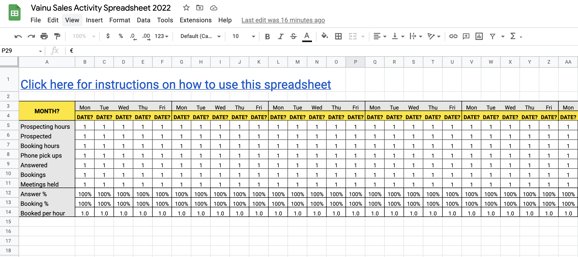How To Keep Track Of Sales With One Spreadsheet?
"If you can't measure it, you can't improve it.” That's one of the most important quotes in business. At least if you want to be data-driven—and who doesn't, right?
Do you want to stay on top of your sales activity and grow a healthy pipeline? Then stay tuned! We’ve designed a sales activity tracking spreadsheet for salespeople to keep track of their daily activities of prospecting, calling, and meeting customers.
This spreadsheet won’t substitute the reporting capabilities of your CRM, but by using a few minutes to fill the spreadsheet every afternoon, you'll quickly understand the areas you should focus on improving. You might realize that you need to increase your booking hit rate or that Thursdays are the best day for calling prospects.
Use this sales activity tracking spreadsheet systematically to learn how to optimize your daily activities quickly. Let's see how easy it is next.
TL;DR: Download the spreadsheet and watch this video to learn how to fill in the data.
How to use this sales activity tracking spreadsheet
Step 1 – Prospecting tracking
Finding potential customers is one of the most arduous and time-consuming stages of the sales process, but it's also one of the most important since much of your success depends on the efficacy of your sales prospecting. So, prospect tracking is the first thing you want to track when you start measuring your sales activity. As you will notice below, prospecting tracking is one of the use cases for our downloadable sales tracker.
Use this spreadsheet to jot down how much time you spend prospecting daily. After a few weeks, you might start uncovering specific trends: do you spend many hours searching the web to find a handful of best-fit prospects? Take note of these trends and use them to inform how you spend your time. Are you curious about what you might be able to do better in terms of prospecting? Then check out our definitive guide to sales prospecting.
Step 2 – Calling tracking
Can you remember how often you've called or emailed a prospect this week? Cold calling is such a high-volume and repetitive task for salespeople that you can easily iterate, test different tactics, and improve quickly.
Write down how many prospects answered your calls and how many meetings you booked. This way, you can keep a close eye on your hit rate as you try different approaches. You might realize that you need to perfect your sales script or that you're making certain cold-calling mistakes.

With this sales activity tracking spreadsheet, you can stay on top of your daily activities of prospecting, calling, and meeting customers.
Step 3 – Tracking Meetings held with the spreadsheet
The number of meetings held is the metric that will inform you whether all of your previous work (prospecting and calling) has produced the desired outcome.
Meeting a potential customer for the first can be nerve-wracking. I recommend you read this guide to first sales meetings to anticipate all the hurdles you'll face.
Analyze the results
Spend a couple of minutes every afternoon filling out the spreadsheet, and you’ll be able to draw some quick yet clear insights on how you’re doing and if you’re on target. The information is very straightforward. And for that, it’s good to maintain a good balance between different sales activities.
The sales activity spreadsheet will also tell you which days are the best for certain activities. Are you booking more meetings on Wednesdays? Then, dedicate more time to calling prospects on Wednesdays.
Beyond sales tracking spreadsheets
Optimizing your sales process with automation and technology continues to be a hot trend. With hundreds of players in the space, choosing the right sales and marketing tech stack for your business can be daunting. That's why we've selected 142 Best B2B Sales Tools and compiled them in this handy guide.
